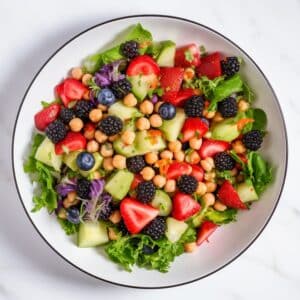
Top your morning fruit with a simple mango sauce. There is lots of fiber in this meal along with Vitamin A, C and K.
This refreshing salad, packed with antioxidants, fiber, and essential nutrients, will tantalize your taste buds while providing a nourishing boost to your health. With the perfect balance of sweetness and tanginess, this Berries Lettuce Chickpeas with Mango Sauce recipe is a delightful way to incorporate a variety of plant-based ingredients into your daily meals.
So, let's dive in and create a vibrant and satisfying dish that will leave you feeling energized and satisfied.

Crunch into Health: The Mighty Nutrients of Celery for Vibrant Living and Stable Blood Glucose Levels
Celery, often celebrated for its crunchy texture and refreshing taste, offers a range of nutritional benefits. It is low in calories and an excellent source of dietary fiber, making it a great choice for those looking to manage their weight or improve digestion.
In terms of vitamins and minerals, celery contains notable amounts of vitamin K, vitamin C, potassium, and folate. Additionally, it provides smaller amounts of vitamins A, B vitamins (such as B6 and B9), and minerals like calcium and magnesium.
When it comes to its impact on blood glucose levels, celery is considered to be a diabetes-friendly food. It has a low glycemic index (GI) and a very low glycemic load (GL), which means that its consumption is less likely to cause a rapid spike in blood glucose levels.
The GI measures how quickly a food raises blood glucose levels compared to pure glucose, while the GL takes into account both the GI and the amount of carbohydrates consumed in a serving. As a result, celery's minimal impact on blood glucose levels makes it a beneficial addition to a diabetes management plan.
By incorporating celery into your meals, you can enjoy its nutritional benefits while supporting stable blood glucose levels. Remember, maintaining optimal blood glucose levels is crucial for individuals living with diabetes, and the consumption of low-GI foods like celery can contribute to overall blood glucose control.

Berry Bliss: Unleash the Nutritional Powerhouse of Strawberries, Blueberries, and Blackberries for Vibrant Health
Berries, including strawberries, blueberries, and blackberries, are not only delicious but also incredibly nutritious. These vibrant fruits are packed with an array of vitamins, minerals, and antioxidants that offer numerous health benefits.
Strawberries:
High in vitamin C, providing over 100% of the recommended daily intake
Good source of folate, potassium, and manganese
Contains fiber, antioxidants, and phytonutrients
Blueberries:
Packed with antioxidants, particularly anthocyanins
Rich in vitamin C and vitamin K
Good source of dietary fiber and manganese
Contains small amounts of vitamin E and copper
Blackberries:
High in antioxidants, including anthocyanins and vitamin C
Good source of dietary fiber and vitamin K
Contains notable amounts of manganese and vitamin E
Provides smaller amounts of other vitamins and minerals like vitamin A and copper
When it comes to their impact on blood glucose levels, berries are considered to be diabetes-friendly fruits. They have a low glycemic index (GI) and a moderate to low glycemic load (GL). The glycemic index measures how quickly a food raises blood glucose levels compared to pure glucose, while the glycemic load takes into account both the GI and the amount of carbohydrates consumed in a serving. Due to their high fiber content and relatively low carbohydrate content, berries have a minimal impact on blood glucose levels, making them a suitable choice for individuals living with diabetes.
By incorporating strawberries, blueberries, and blackberries into your diet, you can enjoy their natural sweetness while reaping the benefits of their low glycemic impact. These delightful fruits not only contribute to overall health with their impressive nutrient profiles but also help maintain stable blood glucose levels, supporting a balanced approach to diabetes management.

Storing Berries for Freshness
Properly storing berries is essential to maintain their freshness and prolong their shelf life.
Sort and Remove Spoiled Berries: Before storing, carefully sort through your berries, discarding any damaged or spoiled ones. This prevents the spread of mold or decay to the rest of the batch.
Keep them Dry: Moisture promotes spoilage, so it's crucial to keep berries as dry as possible. Avoid washing them until just before consumption to prevent excess moisture buildup.
Store in the Refrigerator: Berries are perishable fruits and should be stored in the refrigerator. Place them in a shallow container lined with paper towels or a clean kitchen towel to absorb any excess moisture.
Avoid Crushing: Handle berries gently to avoid bruising or crushing, as this can accelerate spoilage. If using a container with a lid, make sure it's not too tight, allowing for some airflow.
Consume or Freeze Promptly: Berries are at their freshest when consumed within a few days of purchase. If you don't plan to eat them right away, consider freezing them to extend their shelf life. Simply spread them on a baking sheet in a single layer, freeze until firm, and transfer to a freezer-safe container or bag.
By following these storage guidelines, you can maximize the lifespan of your berries, keeping them fresh, juicy, and ready to enjoy in various culinary creations, smoothies, or as a simple snack.


Berries Lettuce Chickpeas with Mango Sauce
Ingredients
- 2 cups Boston lettuce - chopped
- 1 medium celery stalk - chopped
- 1/2 cup blueberries
- 1/2 cup strawberries
- 1 tsp ground cinnamon
- 1 cup cooked chickpeas
- 1 tbsp ground flaxseed or hempseed
- 1/2 medium ripe mango - peeled
- 1/2 medium lemon - juice
Instructions
- In a large bowl place the lettuce, celery, berries and mix well. Top with the cinnamon and flaxseed.
- In a blender blend the mango and lemon juice until smooth.
- Top the fruit mixture with the mango sauce.
- Mix fruit before eating.

